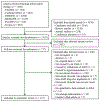Movement disorders associated with antiseizure medications: A systematic review
- PMID: 35483204
- PMCID: PMC9596228
- DOI: 10.1016/j.yebeh.2022.108693
Movement disorders associated with antiseizure medications: A systematic review
Abstract
New-onset movement disorders have been frequently reported in association with the use of antiseizure medications (ASMs). The frequency of specific motor manifestations and the spectrum of their semiology for various ASMs have not been well characterized. We carried out a systematic review of literature and conducted a search on CINAHL, Cochrane Library, EMBASE, MEDLINE, PsycINFO, and Scopus from inception to April 2021. We compiled the data for all currently available ASMs using the conventional terminology of movement disorders. Among 5123 manuscripts identified by the search, 437 met the inclusion criteria. The largest number of reports of abnormal movements were in association with phenobarbital, valproic acid, lacosamide, and perampanel, and predominantly included tremor and ataxia. The majority of attempted interventions for all agents were discontinuation of the offending drug or dose reduction which led to the resolution of symptoms in most patients. Familiarity with the movement disorder phenomenology previously encountered in relation with specific ASMs facilitates early recognition of adverse effects and timely institution of targeted interventions.
Keywords: Adverse effects; Antiseizure medications; Drug-induced; Movement disorder.
Copyright © 2022 Elsevier Inc. All rights reserved.
Figures
References
-
- Zaccara G, Gangemi PF, Cincotta M. Central nervous system adverse effects of new antiepileptic drugs. A meta-analysis of placebo-controlled studies. Seizure 2008;17:405–21. - PubMed
-
- Zaccara G, Cincotta M, Borgheresi A, Balestrieri F. Adverse motor effects induced by antiepileptic drugs. Epileptic Disord 2004;6:153–68. - PubMed
-
- French JA, Kanner AM, Bautista J et al. Efficacy and tolerability of the new antiepileptic drugs II: Treatment of refractory epilepsy: Report of the therapeutics and technology assessment subcommittee and quality standards subcommittee of the american academy of neurology and the american epilepsy society. Neurology 2004;62:1261–73. - PubMed
-
- Panayiotopoulos CP, Benbadis SR, Covanis A et al. Efficacy and tolerability of the new antiepileptic drugs I: Treatment of new onset epilepsy: Report of the therapeutics and technology assessment subcommittee and quality standards subcommittee of the american academy of neurology and the american epilepsy society. Neurology 2005;64:172, 4; author reply 172. - PubMed
Publication types
MeSH terms
Substances
Grants and funding
LinkOut - more resources
Full Text Sources
Medical
Miscellaneous


